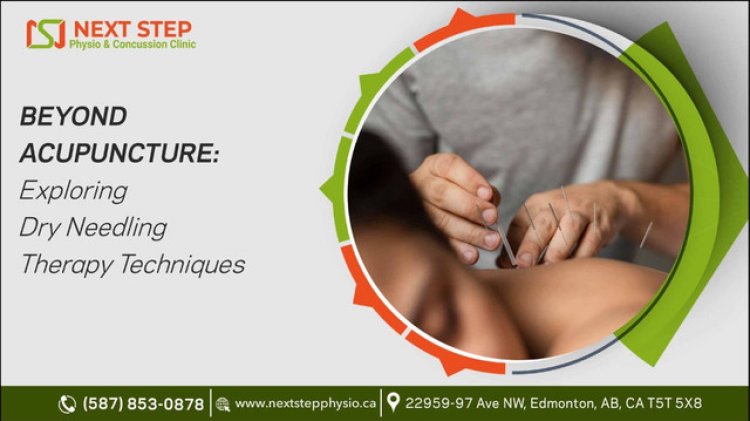How Dry Needling Therapy Differs from Acupuncture
dry needling therapy in Edmonton
Share this Post to earn Money ( Upto ₹100 per 1000 Views )

Dry needling and acupuncture are both techniques that involve inserting thin needles into the skin, but they are fundamentally different in their approach, methodology, and underlying philosophies. At Next Step Physiotherapy, we offer dry needling therapy as part of our comprehensive treatment options. This article will explore the key differences between dry needling therapy in Edmonton, shedding light on how each technique works and what makes them unique.
The Basics of Dry Needling and Acupuncture
Dry Needling:
Dry needling is a modern therapeutic technique primarily used by physiotherapists and other healthcare professionals to treat musculoskeletal pain and dysfunction. The practice involves inserting fine, solid filiform needles into trigger points (knots of muscle) to relieve pain and improve function. The term "dry" refers to the fact that no medication or liquid is injected into the body.
Acupuncture:
It involves inserting thin needles into specific points on the body, known as acupuncture points, to balance the flow of energy (or qi) and promote healing. Acupuncture is based on the principles of traditional Chinese medicine and aims to restore harmony and balance within the body.
Key Differences Between Dry Needling and Acupuncture
Philosophical Foundations
Dry Needling: Dry needling is grounded in Western medical principles and focuses on the neuromuscular system. It is used to diagnose and treat muscle pain, movement impairments, and dysfunctions by targeting trigger points. The technique is based on scientific research and clinical evidence.
Acupuncture: Acupuncture is rooted in traditional Chinese medicine, which views health as a balance of energy (qi) flowing through meridians in the body. Acupuncture points are selected based on their ability to influence the flow of qi and restore balance. The practice is holistic, addressing the body, mind, and spirit.
Treatment Goals
Dry Needling: The primary goal of dry needling is to relieve pain and improve function by releasing trigger points, reducing muscle tension, and enhancing blood flow to the affected area. It is often used to treat conditions such as chronic pain, sports injuries, and muscle tightness.
Acupuncture: Acupuncture aims to restore the body’s energy balance, promote overall wellness, and treat a wide range of conditions. It is used to address not only pain but also digestive issues, stress, anxiety, and other health problems by stimulating the body’s natural healing processes.
Needle Placement and Technique
Dry Needling: Needles are inserted directly into myofascial trigger points or taut bands of muscle. The depth and angle of insertion depend on the location and nature of the trigger point. The needles may be manipulated (twisted, pistoned) to achieve a therapeutic response, such as a local twitch response (LTR), which is a quick contraction and release of the muscle.
Acupuncture: Needles are placed at specific acupuncture points along the body’s meridians. The selection of points is based on the patient’s symptoms and the practitioner’s diagnosis according to traditional Chinese medicine principles. Needles may be inserted shallowly or deeply and are typically left in place for 15-30 minutes without significant manipulation.
Training and Practice
Dry Needling: Practitioners of dry needling are usually licensed healthcare professionals, such as physiotherapists, who have undergone additional training in this specific technique. The training focuses on anatomy, the identification of trigger points, and the safe and effective application of the technique.
Benefits of Dry Needling
Dry needling offers several benefits, particularly for patients with musculoskeletal pain and dysfunction:
Targeted Treatment: By directly addressing trigger points, dry needling can provide fast and effective relief from muscle pain and tightness.
Improved Range of Motion: Reducing muscle tension and releasing trigger points can enhance flexibility and range of motion.
Enhanced Healing: Dry needling promotes blood flow and the body’s natural healing processes,
aiding in the recovery of injured tissues.
Versatility: Dry needling can be used to treat a variety of conditions, including back pain, neck pain, shoulder pain, and sports injuries.
Benefits of Acupuncture
Acupuncture also offers a range of benefits, particularly for holistic health and wellness:
Holistic Approach: Acupuncture addresses the body as a whole, aiming to restore balance and harmony in addition to relieving specific symptoms.
Stress Reduction: Many patients find acupuncture to be relaxing and effective in reducing stress and anxiety.
Broad Applications: Acupuncture can be used to treat a wide range of conditions, including chronic pain, digestive issues, and emotional disorders.
Complementary Therapy: Acupuncture can be used alongside other treatments to enhance overall health and wellness.
Conclusion
Dry needling and acupuncture are distinct techniques with unique approaches and benefits. At Next Step Physiotherapy in Edmonton, we specialize in dry needling to effectively treat musculoskeletal pain and dysfunction. Understanding the differences between these therapies can help you make informed decisions about your treatment options. If you are experiencing pain or muscle tightness, contact us to learn more about how dry needling therapy can help you achieve relief and improved function.
#dryneedlingedmonton #dryneedlingnearme #dryneedlingtherapyedmonton #dryneedlingtherapy #dryneedlingtherapynearme #imstherapyedmonton #imstherapy #physicaltherapyedmonton #physicaltherapy #physiotherapy #physiotherapyedmonton #nextstepphysiotherapyedmonton #physicaltherapist #physiotherapyclinic #physioclinicedmonton





![Patriot Slim Shot Reviews [New Updates 2024] — Does It Work & Is It Safe?](https://blog.rackons.in/uploads/images/202410/image_380x226_66fba0cc3bbfe.jpg)


